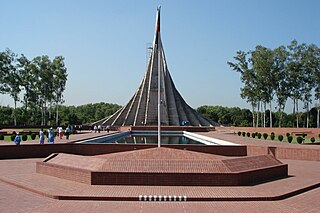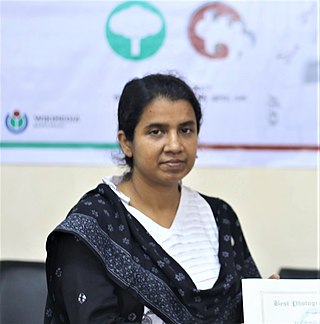
The Triangle Shirtwaist Factory fire in the Greenwich Village neighborhood of Manhattan, New York City, on Saturday, March 25, 1911, was the deadliest industrial disaster in the history of the city, and one of the deadliest in U.S. history. The fire caused the deaths of 146 garment workers – 123 women and girls and 23 men – who died from the fire, smoke inhalation, falling, or jumping to their deaths. Most of the victims were recent Italian or Jewish immigrant women and girls aged 14 to 23; of the victims whose ages are known, the oldest victim was 43-year-old Providenza Panno, and the youngest were 14-year-olds Kate Leone and Rosaria "Sara" Maltese.

The International Labor Rights Forum (ILRF) is a nonprofit advocacy organization headquartered in Washington, D.C., U.S., that describes itself as "an advocate for and with the working poor around the world." ILRF, formerly the "International Labor Rights Education & Research Fund", was founded in 1986, and the organization's mission statement reads: "ILRF believes that all workers have the right to a safe working environment where they are treated with dignity and respect, and where they can organize freely to defend and promote their rights and interests. ILRF works to develop practical and effective tools to assist workers in winning enforcement of protections for their basic rights, and hold labor rights violators accountable."

Savar is an upazila of Dhaka District in the division of Dhaka, Bangladesh and is located at a distance of about 24 kilometers (15 mi) to the northwest of Dhaka city. Savar is mostly famous for the National Martyrs' Memorial, the national monument for the martyrs of the Liberation War of Bangladesh.

The textile and clothing industries provide a single source of growth in Bangladesh's rapidly developing economy. Exports of textiles and garments are the principal source of foreign exchange earnings. By 2002 exports of textiles, clothing, and ready-made garments (RMG) accounted for 77% of Bangladesh's total merchandise exports. Emerging as the world's second-largest exporter of ready-made garment (RMG) products, Bangladesh significantly bolstered employment within the manufacturing sector.
Dragon Group is a group of garment factories and other companies in Bangladesh. The group produces mainly for the international market and exports to more than 30 countries, especially the United States and Canada. Its subsidiary Dragon Sweater employs more than few thousand workers and in 2018 was the most traded stock on the Dhaka Stock Exchange.

KiK, legally KiK Textilien und Non-Food GmbH, is a German clothing discount store chain headquartered in Bönen.

Bonmarché is a clothing retailer based in Wakefield, West Yorkshire. The business was founded in 1982, and was acquired by the Peacock Group in July 2002.
Aminul Islam was a Bangladeshi trade unionist who was murdered in 2012 and gained international attention.

Ha-Meem Group is one of the largest Bangladeshi conglomerates in textile and garments sector. It owns 26 garments factories, sweater factory, poly bag industry, label factory, jute mill, chemical formulation plant, tea estates, transport company, Channel 24 and Samakal, a widely circulated national daily newspaper. The newspaper are under Times Media Limited of Ha-Meem Group. It employs 50 thousand people.

The Rana Plaza collapse was a structural failure that occurred on 24 April 2013 in the Savar Upazila of Dhaka District, Bangladesh, where an eight-storey commercial building called Rana Plaza collapsed. The search for the dead ended on 13 May 2013 with a death toll of 1,134. Approximately 2,500 injured people were rescued from the building. It is considered the deadliest accidental structural failure in modern human history, as well as the deadliest garment-factory disaster in history and the deadliest industrial accident in the history of Bangladesh.
The Accord on Fire and Building Safety in Bangladesh was signed on 15 May 2013. It is a five-year independent, legally binding Global Framework Agreement between global brands, retailers, and trade unions designed to build a safe and healthy Bangladeshi Ready Made Garment (RMG) Industry. The agreement was created in the immediate aftermath of the Rana Plaza building collapse in Bangladesh that resulted in the death of more than 1100 people and injured more than 2000. In June 2013, an implementation plan was agreed leading to the incorporation of the Bangladesh Accord Foundation in the Netherlands in October 2013.

Clothing industry or garment industry summarizes the types of trade and industry along the production and value chain of clothing and garments, starting with the textile industry, embellishment using embroidery, via the fashion industry to apparel retailers up to trade with second-hand clothes and textile recycling. The producing sectors build upon a wealth of clothing technology some of which, like the loom, the cotton gin, and the sewing machine heralded industrialization not only of the previous textile manufacturing practices. Clothing industries are also known as allied industries, fashion industries, garment industries, or soft goods industries.
The Alliance for Bangladesh Worker Safety, also known as "the Alliance" or AFBWS, is a group of 28 major global retailers formed to develop and launch the Bangladesh Worker Safety Initiative, a binding, five-year undertaking with the intent of improving safety in Bangladeshi ready-made garment (RMG) factories after the 2013 Rana Plaza building collapse. Collectively, Alliance members represent the majority of North American imports of ready-made garments from Bangladesh, produced in more than 700 factories.
The 2005 Dhaka garment factory collapse or Spectrum garment factory collapse was a structural failure that occurred on Monday, 11 April 2005 in the Savar Upazila of Dhaka, Bangladesh where a nine-story commercial building collapsed. The site is located about 30 km northwest of Dhaka. The explosion of a boiler on the ground floor triggered the collapse. The owner of the building was Shahriar Sayeed Husain, a Bangladeshi businessman. He is married to Farah Mahbub, a judge of Bangladesh High Court.

Taslima Akhter is a Bangladeshi activist and photographer. She is a graduate of Dhaka University, as well as the photography school Pathshala. She is a member of several activist organizations. While documenting the Rana Plaza collapse in 2013, she took a photograph of a woman and a man who had died in each other's arms, which became emblematic of the incident.
The Garment Workers Unity Forum (GWUF) is a national trade union federation of garment workers in Bangladesh.
The National Garment Workers Federation (NGWF) is a registered national trade union federation of garment workers in Bangladesh. With 87 registered factory unions, it ifs considered one of the four main federations of garment workers' unions. NGWF is the initiator and a member of the Bangladesh Garments Workers Unity Council and a member of the Bangladesh Center for Workers' Solidarity. It is affiliated with the IndustriALL Global Union and one of the signatories of the Bangladesh Accord.
The Bangladesh Garments Workers Unity Council (BGWUC) is a national trade union centre in Bangladesh. The centre unites 21 garment worker trade union federations.
Mushrefa Mishu is a Bangladeshi trade unionist and politician. She is the current president of the Garment Workers Unity Forum and general secretary of Bangladesh's Democratic Revolutionary Party.
On the night of 4 June 2022, a fire and subsequent explosions at a container depot in Sitakunda Upazila, Chittagong District, Bangladesh killed at least 47 people and injured around 450 others.










